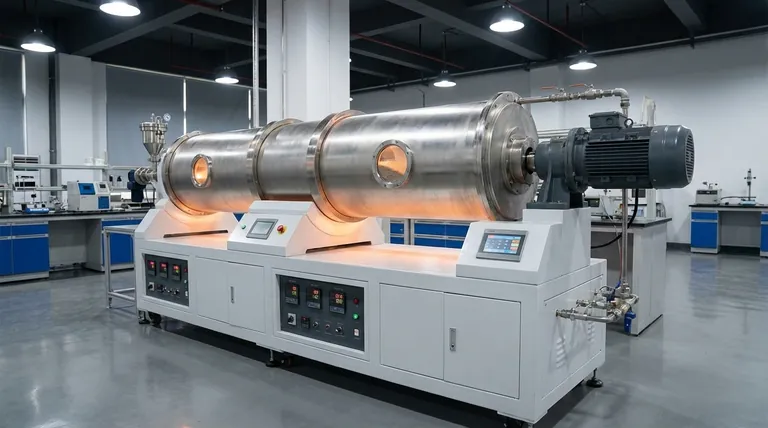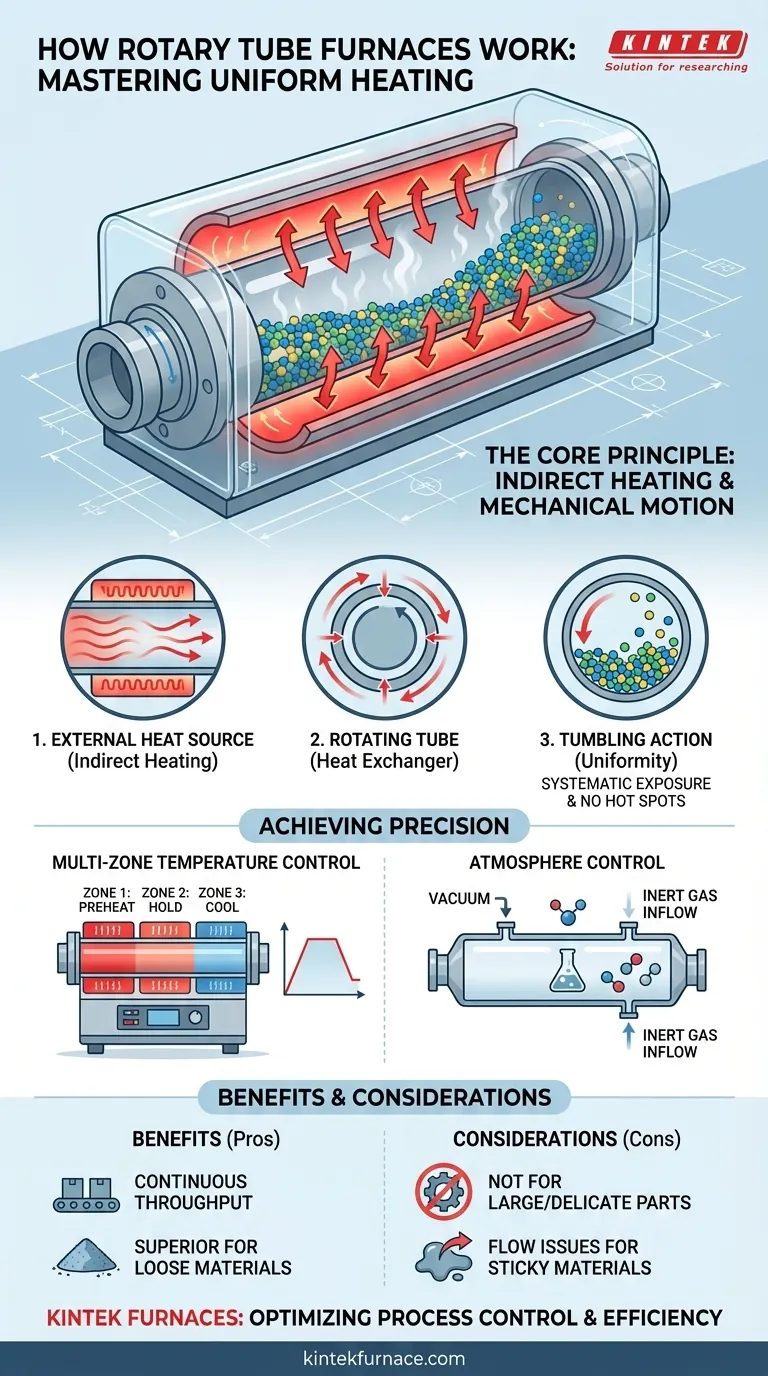Rotary tube furnaces operate by using an external heat source to heat a slowly rotating cylindrical tube. As the material inside tumbles, it is continuously mixed and brought into contact with the hot inner walls of the tube, ensuring exceptionally uniform and efficient heat transfer throughout the entire batch.
The core principle of a rotary tube furnace is not just about reaching a target temperature, but about using mechanical rotation to solve the persistent challenge of heating loose, flowing materials evenly in a continuous, dynamic process.

The Core Principle: Indirect Heating and Mechanical Motion
A rotary tube furnace's design elegantly combines two fundamental concepts: indirect heating and constant material agitation. This pairing is what makes it so effective for specific industrial and laboratory applications.
The External Heat Source
The process begins with heat being generated outside the main processing chamber. This is typically achieved with high-power electric heating elements or, in some designs, gas burners that produce hot flue gases.
This method is known as indirect heating. The material being processed never comes into direct contact with the heating elements or combustion byproducts, which is critical for maintaining material purity and controlling the chemical environment.
The Rotating Tube as a Heat Exchanger
The central component is the cylindrical tube, which slowly rotates on its longitudinal axis. This tube acts as a highly efficient heat exchanger.
Its outer surface absorbs the thermal energy from the external heating elements. That heat is then conducted through the tube wall to the inner surface, where it is transferred to the process material.
The Critical Role of Rotation in Uniformity
The rotation is the key to the furnace's effectiveness. As the tube spins, the loose material inside (such as powders, granules, or pellets) is constantly lifted and tumbled.
This tumbling action ensures that all particles are systematically exposed to the hot inner wall of the tube. It eliminates static hot spots and cold spots common in stationary furnaces, resulting in a remarkably uniform temperature distribution throughout the material batch.
Achieving Precision: Zones and Atmosphere Control
Modern rotary tube furnaces offer sophisticated controls that move beyond simple heating to enable precise, repeatable material processing.
Multi-Zone Temperature Control
Many furnaces are designed with multiple, independent thermal control zones along the length of the tube. This allows operators to create a specific temperature profile.
For example, a material can be rapidly heated in the first zone, held at a precise processing temperature through the middle zones, and then gradually cooled in the final zone, all within a single continuous pass.
Managing the Process Atmosphere
These furnaces are exceptionally well-suited for processes that require a specific gaseous environment. The sealed nature of the tube allows for operation under vacuum conditions or for the introduction of a controlled atmosphere.
Ports for inert gas (like nitrogen or argon) and outgassing allow operators to prevent unwanted oxidation or facilitate specific chemical reactions, such as in Chemical Vapor Deposition (CVD).
Understanding the Trade-offs and Considerations
While powerful, a rotary tube furnace is a specialized tool. Understanding its strengths and limitations is key to using it effectively.
Benefit: Continuous Throughput
Unlike batch ovens, these furnaces are designed for continuous or semi-continuous material flow. This makes them ideal for industrial production where high throughput is necessary to meet manufacturing demands.
Benefit: Superior for Loose Materials
The design is optimized for processing loose, free-flowing materials like powders, ores, and pellets. The tumbling action not only heats the material but also helps drive off moisture and other volatiles efficiently.
Limitation: Material Suitability
This method is not suitable for large, solid parts, delicate structures that could be damaged by tumbling, or liquids. The process relies entirely on the material's ability to flow and tumble freely.
Potential Pitfall: Material Flow Issues
Some materials, particularly high-viscosity organic substances, can become sticky when heated and may clump or coat the inside of the tube. Advanced features like hammer vibrators or heating jackets may be required to prevent condensation and ensure consistent material flow.
Is a Rotary Tube Furnace Right for Your Process?
Choosing the right thermal processing equipment depends entirely on your material and your goal.
- If your primary focus is high-volume, continuous production of powders or pellets: A rotary tube furnace is an ideal choice for its unmatched throughput and process efficiency.
- If your primary focus is achieving maximum temperature uniformity in a loose material: The rotational mechanism is superior to static ovens for preventing hot spots and ensuring consistent product quality.
- If your primary focus is a sensitive chemical process like calcination or CVD: The combination of precise temperature zoning and atmosphere control makes this a powerful and necessary tool.
Ultimately, selecting a rotary tube furnace is a decision to prioritize process control, uniformity, and continuous throughput for granular materials.
Summary Table:
| Feature | Description |
|---|---|
| Heating Method | Indirect heating via external elements, ensuring material purity |
| Rotation | Continuous tumbling for uniform heat distribution and mixing |
| Material Suitability | Ideal for loose, free-flowing materials like powders and pellets |
| Temperature Control | Multi-zone systems for precise profiles and repeatable results |
| Atmosphere Control | Sealed tube allows vacuum or controlled gas environments (e.g., inert gases) |
| Throughput | Designed for continuous or semi-continuous high-volume production |
| Limitations | Not suitable for large solids, delicate items, or liquids; may require vibrators for flow issues |
Upgrade your lab's thermal processing with KINTEK's advanced rotary tube furnaces! Leveraging exceptional R&D and in-house manufacturing, we provide diverse laboratories with tailored high-temperature solutions. Our product line, including Rotary Furnaces, Muffle, Tube, Vacuum & Atmosphere Furnaces, and CVD/PECVD Systems, is complemented by strong deep customization capabilities to precisely meet your unique experimental needs. Whether you're handling powders, granules, or require continuous throughput, our furnaces ensure uniform heating, precise control, and enhanced efficiency. Contact us today to discuss how we can optimize your process and deliver reliable results!
Visual Guide

Related Products
- Vacuum Sealed Continuous Working Rotary Tube Furnace Rotating Tube Furnace
- Split Multi Heating Zone Rotary Tube Furnace Rotating Tube Furnace
- 1700℃ High Temperature Laboratory Tube Furnace with Quartz or Alumina Tube
- Laboratory Vacuum Tilt Rotary Tube Furnace Rotating Tube Furnace
- 1400℃ High Temperature Laboratory Tube Furnace with Quartz and Alumina Tube
People Also Ask
- What are the key advantages of rotary tube furnaces? Achieve Superior Uniformity and Efficiency for Your Materials
- What are the key features of a rotary furnace? Achieve Superior Uniformity and Control
- How do rotary tube furnaces contribute to material science and chemical engineering? Unlock Precision in Material Processing
- How are rotary tube furnaces utilized in industrial production? Boost Efficiency with Uniform Thermal Processing
- What other fields utilize rotary tube furnaces? Discover Versatile Heating Solutions for Multiple Industries



















